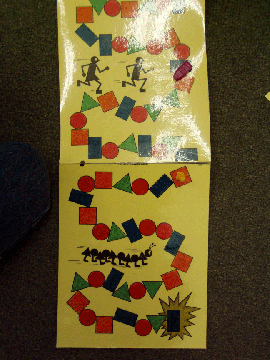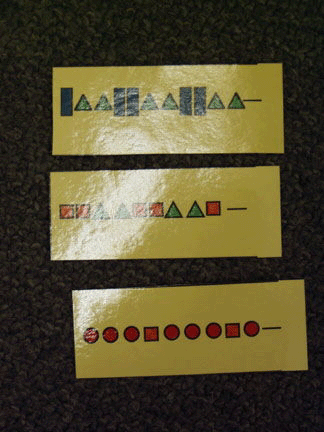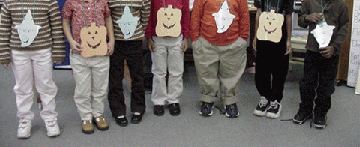|
Patterning

Dye seasonal macaroni, paint lima beans
or use math manipulatives for patterning, counting sets, graphing or
acting out story problems. I store individual sets of manipulatives
in film containers. Then I place the thematic sets (story boards and
manipulatives) in plastic shoe boxes so they are always ready to
use. The math mats are Box It or Bag It's Storyboards. |
|

This "Shape Race" game uses the pattern
cards on the right for the players to move toward the finish box.
This is an old game by Box It or Bag It Math. |

These pattern cards are placed face down.
Players take turns drawing a card and telling what comes next in the
pattern. Then they move their marker on the Shape Race game to the
next place that shape appears on the gameboard. |
|

Wear costume cards to form patterns or to
act out story problems. These are from Box It or Bag It.
|
The best way
to teach patterns-is to look at the frequency that patterns occur in
everyday life: day/night/day/night/ would translate into abababab or
the two color tile on the floor/wall. Fall/winter/spring/summer
would be an abcd pattern. Also, look at number sequences. Patterns
form the basis of all mathematics, simple and complex. But
every complex thing can be broken down into the simple components;
in other
words, know why you are teaching a certain pattern and inform the
students. |
|
Try
clapping/tapping patterns for a transition activity and have the
children join in. Try clapping once, then patting your head once and
label it ABAB as you do it. This makes a great transition activity.
Then invite children to show you a pattern and have everyone try to
copy it.
|
Have your students
use sticky colored dots to make patterns on a paper strip (and label
them with pencil right on the dot--ABABAB). Start with simple
patterns like AB. When they've mastered that, try more complicated
ones. |
|
Marilyn Burns uses
an introduction to patterns where the teacher builds several
different patterns with unifix cubes, but hides them inside a tube
of construction paper (roll up a sheet of construction paper, long
or short), but a paper towel roll or toilet paper roll could also be
used. Make the pattern towers of unifix cubes just long enough to
fit inside the tube and pull them out, one cube at a time, having
the children predict what will come next. For instance, if you
have an orange/black AB pattern in one of the tubes, show the
children the first unifix cube that is black. Then ask if anyone has
a prediction about what will come next. Ask them why they think so.
Then show them the next cube that is orange and ask again for a
prediction of what will come next. Continue asking and showing the
pattern. They will begin to see the predictability of the pattern.
Talk about how a good pattern is very predictable with a good
beginning and a good ending---an AB pattern will always begin with
an A and end with a B. Try an AABB pattern in the tube and an ABC
pattern. If they catch on, add more complicated ones. |
Talk about
patterns all around them---on clothing, in words, in books (rhyming
patterns, repeated lines, black/white pages interspersed with color
pages). Tell them that if they are skilled at recognizing patterns,
they will be good at math. |